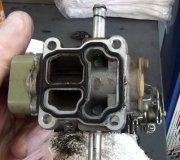Thursday, March 11th, 2010 AT 5:13 PM
When I turn my truck on, it fires up and then only idles back down to about 1400 RPM (usually around 8 or 900). I can cruise on flat ground at 35mph and take my foot off the gas, the truck will hold that speed until I brake because of the high running speed. The CEL came on at the same time that the problem started. I found a vacuum leak and fixed it, have replaced the idle air control valve, the MAP sensor, and have cleaned the throttle body. The error code says replace the idle air control valve, which I have already replaced even though the symptoms didn't suggest it (I have replaced IACV twice before). I have followed the vacuum hose as far as I can but haven't found any cracks. When this problem first started, when cold, the engine would idle fine but as it warmed up it would begin to idle faster. Now, it idles high as soon as I start it. If I coast down from about 45 or 50, a few seconds after I take my foot off the pedal I can feel and hear it drop down to normal speed momentarily, then speed back up. I have a K&N intake, shorty headers, and an aftermarket muffler with no cat, if that means anything.



